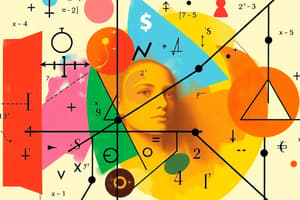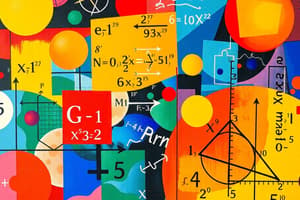Podcast
Questions and Answers
Which branch of mathematics focuses on studying shapes and sizes?
Which branch of mathematics focuses on studying shapes and sizes?
- Geometry (correct)
- Calculus
- Statistics
- Algebra
What type of numbers includes positive integers and zero?
What type of numbers includes positive integers and zero?
- Whole Numbers (correct)
- Natural Numbers
- Integers
- Irrational Numbers
Which theorem states that every non-constant polynomial equation has at least one complex root?
Which theorem states that every non-constant polynomial equation has at least one complex root?
- Central Limit Theorem
- Mean Value Theorem
- Pythagorean Theorem
- Fundamental Theorem of Algebra (correct)
What is the formula to calculate the area of a rectangle?
What is the formula to calculate the area of a rectangle?
Which of the following operations represents repeated addition?
Which of the following operations represents repeated addition?
What is the value of the derivative of a constant function?
What is the value of the derivative of a constant function?
What defines a rational number?
What defines a rational number?
Which geometric property measures the total distance around a shape?
Which geometric property measures the total distance around a shape?
Flashcards are hidden until you start studying
Study Notes
Key Concepts in Mathematics
1. Branches of Mathematics
- Arithmetic: Basic operations (addition, subtraction, multiplication, division).
- Geometry: Study of shapes, sizes, and properties of space.
- Algebra: Use of symbols and letters to represent numbers in equations.
- Calculus: Study of change (derivatives and integrals).
- Statistics: Collection, analysis, interpretation, presentation of data.
- Probability: Study of randomness and uncertainty.
- Discrete Mathematics: Study of mathematical structures that are fundamentally discrete rather than continuous.
2. Basic Operations
- Addition (+): Combining quantities.
- Subtraction (−): Finding the difference between quantities.
- Multiplication (×): Repeated addition.
- Division (÷): Splitting into equal parts.
3. Number Types
- Natural Numbers: Positive integers (1, 2, 3, ...).
- Whole Numbers: Natural numbers including zero (0, 1, 2, ...).
- Integers: Whole numbers and their negatives (..., -2, -1, 0, 1, 2, ...).
- Rational Numbers: Numbers that can be expressed as a fraction (a/b, where b ≠ 0).
- Irrational Numbers: Numbers that cannot be expressed as a simple fraction (e.g., √2, π).
- Real Numbers: All rational and irrational numbers.
4. Fundamental Theorems
- Pythagorean Theorem: In a right triangle, ( a^2 + b^2 = c^2 ) (where c is the hypotenuse).
- Fundamental Theorem of Algebra: Every non-constant polynomial equation has at least one complex root.
- Central Limit Theorem: Distribution of sample means approximates a normal distribution as sample size increases.
5. Geometric Principles
- Perimeter: Total distance around a shape.
- Area: Size of a surface (e.g., rectangle: length × width).
- Volume: Space occupied by a 3D object (e.g., cube: side³).
- Angles: Measured in degrees; types include acute (< 90°), right (= 90°), obtuse (> 90°).
6. Key Algebraic Concepts
- Equations: Mathematical statements asserting equality (e.g., ( ax + b = c )).
- Functions: Relationships between inputs and outputs (e.g., ( f(x) = mx + b )).
- Polynomials: Expressions of variables raised to non-negative integer powers.
7. Calculus Concepts
- Limits: Value that a function approaches as the input approaches a certain point.
- Derivatives: Measure of how a function changes as its input changes.
- Integrals: Measure of the area under a curve.
8. Statistical Concepts
- Mean: Average of a set of numbers.
- Median: Middle value when numbers are sorted.
- Mode: Most frequently occurring number in a set.
- Standard Deviation: Measure of how spread out numbers are around the mean.
9. Probability Concepts
- Experiment: An action or process that leads to one or more outcomes.
- Event: A set of outcomes of an experiment.
- Probability Formula: ( P(E) = \frac{\text{Number of favorable outcomes}}{\text{Total number of outcomes}} ).
These notes provide a structured overview of essential mathematics concepts and principles, serving as a useful reference for study and review.
Branches of Mathematics
- Arithmetic encompasses basic operations: addition, subtraction, multiplication, and division.
- Geometry involves the study of shapes, sizes, and spatial properties.
- Algebra uses symbols and letters to create and solve equations.
- Calculus focuses on the study of change, specifically through derivatives and integrals.
- Statistics involves collecting, analyzing, interpreting, and presenting data.
- Probability studies randomness, uncertainty, and the likelihood of events.
- Discrete Mathematics examines mathematical structures that are fundamentally distinct and separate rather than continuous.
Basic Operations
- Addition (+) is the process of combining quantities to achieve a total.
- Subtraction (−) involves calculating the difference between two quantities.
- Multiplication (×) can be understood as repeated addition of the same quantity.
- Division (÷) is the method of distributing a quantity into equal parts.
Number Types
- Natural Numbers are positive integers starting from 1 (e.g., 1, 2, 3).
- Whole Numbers include natural numbers and zero (e.g., 0, 1, 2).
- Integers encompass whole numbers and their negative counterparts (..., -2, -1, 0, 1, 2).
- Rational Numbers can be expressed as the ratio of two integers (a/b, b ≠ 0).
- Irrational Numbers cannot be expressed as simple fractions (examples include √2 and π).
- Real Numbers combine all rational and irrational numbers.
Fundamental Theorems
- The Pythagorean Theorem states that in a right triangle, the square of the length of the hypotenuse (c) equals the sum of the squares of the other two sides (a and b).
- The Fundamental Theorem of Algebra asserts every non-constant polynomial equation has at least one complex root.
- The Central Limit Theorem indicates that as the sample size increases, the distribution of sample means approximates a normal distribution.
Geometric Principles
- Perimeter is the total distance around a geometric shape.
- Area refers to the quantity of space within a two-dimensional shape, such as length multiplied by width for rectangles.
- Volume measures the space occupied by a three-dimensional object, as calculated for a cube by side³.
- Angles are measured in degrees; include types such as acute (< 90°), right (= 90°), and obtuse (> 90°).
Key Algebraic Concepts
- Equations represent mathematical statements of equality, such as ( ax + b = c ).
- Functions define specific relationships between inputs and outputs, exemplified by ( f(x) = mx + b ).
- Polynomials consist of terms with variables raised to non-negative integer powers.
Calculus Concepts
- Limits refer to the value a function approaches as the input nears a specific point.
- Derivatives quantify how a function's output changes when its input varies.
- Integrals calculate the area under a curve, emphasizing accumulation and total values.
Statistical Concepts
- Mean denotes the average value of a numerical set.
- Median is the central value in an ordered list of numbers.
- Mode identifies the most frequently occurring number within a data set.
- Standard Deviation indicates how spread out the values are around the mean.
Probability Concepts
- An Experiment is an action or process that results in one or more outcomes.
- An Event consists of a specific set of outcomes derived from an experiment.
- The Probability Formula calculates the likelihood of an event occurring: ( P(E) = \frac{\text{Number of favorable outcomes}}{\text{Total number of outcomes}} ).
Studying That Suits You
Use AI to generate personalized quizzes and flashcards to suit your learning preferences.




